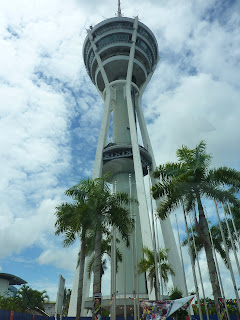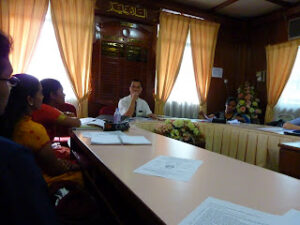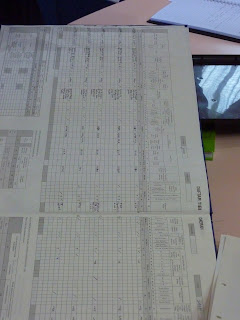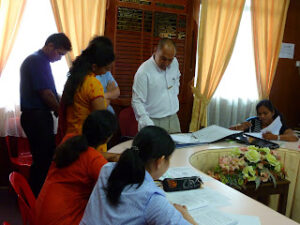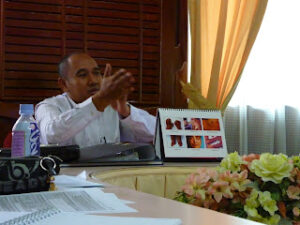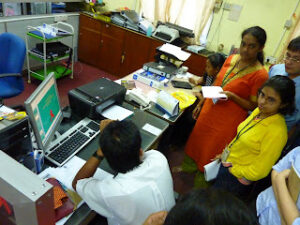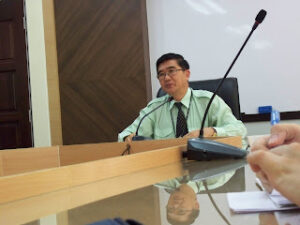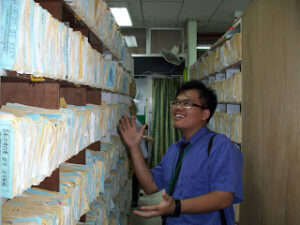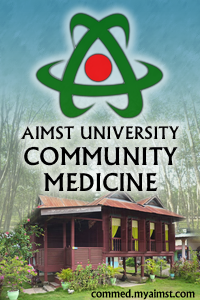We were welcomed by Mr.Cheang, Health Inspectorate, at 9.30pm. He gave a brief talk on the enforcement of tobacco usage, He further explained on the smoking issue among the community of Kota Setar. He also provided us with a list of prohibited areas to smoking and shared some personal experiences of his own while he was carrying out his duties. The job sounded cool..:)…but dangerous!…..He then reffered us to Mr.Yong who is currently incharge of the non-CDC department……
Mr.Nazri, another Health Inspectorate then took over where he spoke on Tuberculosis and Leprosy. He provided us with a copy of the epidemiology and the statistical data for the prevalence of tuberculosis in the district of Kota Setar. The referral system for a patient with sputum positive results is as follows:
Some of the criteria in this TBIS system are:
a. DHO will become the centre for data collection, and the reports are given to the district
b. Main reports are from the DHO which start from the treatment centre
c. State level report is sent to the ministry 3 months once
d. All cases even from the private sector are registered at DHO according to residence address
e. Patients data and the lab results are important according to DOTS
The main 5 components of DOTS:
a. Leadership commitments
b. Case detection through sputum evaluation
c. Standardized regime treatment usage and DOTS
d. Continuous medical supply
e. Uniform Information Management System
Mr.Nazri then continued on a briefing about leprosy. He told us that there was only 2 reported cases in Kota Setar. There are 2 types of mycobacterium leprae namely multibacillary( contagious) and paucibacillary (non-contagious). This desease is spread by bodily contact.
The day was further prolonged by another talk by Mr.Hasrul who is incharge of the HIV unit of the Kota Setar district. He showed us slide presentations on the disease prevalence in this district. He was happy that the prevalence rate has dropped over these years due to the effectiveness of programs conducted by various levels of the community such as PROSTAR, NSEP, and Health Carnivals.
Nurse Rozaini and Mr. Fitri of the KPAS unit had a discussion with us shortly after Mr.Nazri’s. They briefed us on occupational hazards such as accidents at work place, acquired skin and lung diseases, and noise induced hearing loss. There are separate forms that are filled up according to each hazard eg: WEHU A1, WEHU S1 S2, and WEHU L1….:)
Finally we left for lunch and returned for the last session of the day at 2.30pm with Mr. Yong. We had a discussion on non-CDC such as Diabetic Programme, Hypertension Programme, Asthma, Obesity Programme and Quit Smoking Clinic. He told us that in future the Mental Programme will be included as one of the non-CDC aswell. In Kota Setar district there is a 25% of successfull rate of the counselling session for the Quit Smoking Clinic and there are about 19000 reported of diabetes till this year at the Diabetic Clinic.
Our day finally ended with Mr.Yong showing us around the Diabetic Health Clinic and also to the record storage room…….
It was a hectic day, but however we enjoyed ourselves!
**Ranjeeta**
Source: dhokotastarb12.blogspot.com

